LUA分享——认识植物,培养孩子想象力与创造力
Posted 加拿大独角兽启智园LUA
tags:
篇首语:本文由小常识网(cha138.com)小编为大家整理,主要介绍了LUA分享——认识植物,培养孩子想象力与创造力相关的知识,希望对你有一定的参考价值。
Unicorn online sharing is back!
This time, Teachers will take you to Ms Fancy farmland crops to explore the power of natural. Ms Shiny will bring you to the world of Visual Art. Ms Nana and Mr Shine will bring children go to swim in water, following Ms Summer, to paint The inside to see what is good, what is not good...
独角兽的线上分享又来啦!
待在家里的这段日子,大家是不是都很想念外面的风景呢?这次,Fancy老师将带大家去农田认识农作物,而且还会学习相关英文知识,Shiny老师,将带着小U们去发现自然界里不同的植物,增加小U的艺术体验,娜娜老师和The shy老师,将带着小U去水里遨游,和水先生相互认识一下,或者跟着Summer老师,去绘本里面看看什么是好吃的,什么是不好吃的……
探索发现
▲What part of the plant do we eat?
Activity objectives:
1. Introduce vegetables: potatoes, lettuce,cabbage,beans. Let kids understand their growth status and characteristics.
2. Know the different characteristics of roots, stems, leaves, flowers and fruits of different plants .
3. Guide children to observe the characteristics of common vegetables in their lives and stimulate them to explore natural things.
活动目标:
1.介绍蔬菜,土豆、莴苣、卷心生菜、豌豆,了解它们的生长状态和特征。
2.通过观察、探索,初步了解不同植物根、茎、叶、花、果的不同特征。
3.引导孩子观察自己生活中常见蔬菜的特征,激发孩子们对自然事物的探索欲。
蔬菜的组成部分
In the last video, our children learned about the conditions for plant growth. Then, today we're going to take a look at which parts of vegetables are edible?
In general, as plants grow, they will have roots, stems, leaves, flowers, and fruits. But are these parts edible? Different plants have different answers.
1.Root vegetables.
This type of vegetable is characterized by storage resistance, transportation resistance, and contains a lot of starch or sugar. It is a non-staple food with high heat energy. In addition to being a vegetable, it can also be used as a raw material for the food industry for further processing.
2.Stem vegetables
The main part of vegetables for human consumption is the stem. Stems can be divided into aerial stem vegetable (lettuce, bamboo shoots, etc.) and subterranean stem vegetable (ginger, taro, etc.).
3. Leaf vegetables
There are many kinds of leaf vegetables. The leaves of these vegetables are large, fresh and tender and have a lot of water content. They are the main vegetables sold on the market.
4. Flowers and vegetables
Relatively speaking, there are fewer varieties of this kind of vegetables, mainly two kinds of cauliflower and day lily, both of which take the flower tube as the edible part.
5. Fruit and vegetables
The common characteristic of fruit vegetables is that they originated in the tropics, which is the main vegetable in summer in China.
In addition to the four vegetables we know today, can you consider that what other vegetables we eat in different parts? Please tell us in the comment area below!
在上一期视频中,孩子们了解了植物生长的条件。那么,今天我们再来了解下蔬菜的哪些组成部分是可以食用的呢?
通常情况下,伴随着植物的生长,它会有根、茎、叶、花、果。但是这几个部分都是可以食用的么?不同的植物有不同的答案。
1.根茎类
这类蔬菜的特点是耐储存、耐运输,并含有大量的淀粉或糖类,是热能很高的副食品,除做蔬菜外还可以作为食品工业原料来进一步加工。
2.茎菜类
茎菜类蔬菜供人食用的主要部分是茎部。茎分为地上茎(莴笋、竹笋等)和地下茎(姜、芋头等)。
3.叶类菜
叶类菜蔬菜的种类很多,这类菜的叶子肥大、鲜嫩、含水量较多,是市场上主要供应的蔬菜。
4.花菜类
这类菜的品种较少,主要有花椰菜和黄花菜两种,均以花器官为食用部分。
5.果菜类
果菜类蔬菜的共同特点是起源于热带,它是我国夏季的主要蔬菜。
除了今天了解的四种蔬菜,你知道,还有哪些蔬菜我们吃的是它们不同的部位么?请在下方留言告诉我们吧!
视觉艺术
Activity objectives:
1. Discover different plants in nature ,observe different plants and recognize their different shapes, sizes and tactile sensations to increase children's artistic experience.
2.life is full of art,we should cultivate children to seek for beauty in life.
3.Children themselves design, combine, arrange and collage plants, and they use their imagination to refresh and create the nature materials.
活动目的:
1、发现自然中不同植物,观察和感受不同形状、大小、触感的植物,增加孩子的艺术经验。
2、生活处处是艺术,培养孩子善于发现美的眼睛。
3、孩子们自己设计,组合,排列,拼贴植物,用自己的想象力赋予自然物新的色彩和创造
Activity preparation:
Collect natural flowers, grass, leaves, branches and other natural materials, glue, paper, scissors
活动准备:
收集自然中花、草、叶子、树枝等自然材料,胶水,卡纸,剪刀
绘本时光
绘本一:
▲绘本《Yummy Yucky 》
Yummy Yucky
《好吃难吃》
spaghetti is yummy
worms are yucky
意大利面是好吃的
蠕虫是难吃的
blueberries are yummy
blue crayons are yucky
蓝莓是好吃的
蓝色蜡笔是难吃的
soup is yummy
soap is yucky
汤是好吃的
肥皂是难吃的
sandwiches are yummy
sand is yucky
三明治是好吃的
沙子是难吃的
Mommy's cookies are yummy
Mommy's coffee is yucky
妈妈的饼干很好吃
妈妈的咖啡很难喝
chocolate sauce is yummy
hot sauce is yucky
巧克力酱是好吃的
辣酱是难吃的
apple pie is yummy
mud pie is yucky
苹果派是好吃的
泥馅饼是难吃的
burgers are yummy
boogers are yucky
汉堡是好吃的
鼻涕是难吃的
fish sticks are yummy
fish food is yucky
鱼肉是好吃的
鱼食是难吃的
eggs are yummy
are wax is yucky
鸡蛋是好吃的
耳屎是难吃的
ice cream is yummy
too much ice cream is yucky
冰淇淋是好吃的
吃太多冰淇淋会恶心
More yucky things
garbage / apple core / dish soap / dog food / centipede / stinky sock / toilet paper / kitty litter
更多难吃的食物:垃圾/苹果核/狗食/洗洁精/蛔虫/卫生纸/猫食/臭袜子
More yummy thins
cheese / milk / banana / pizza / toast / chicken / peach / cup cakes
更多好吃的食物:芝士/牛奶/香蕉/披萨/土司肉/桃子/纸杯蛋糕
The End
Between the ages of 1-3 year old kids.especially those between 1.5 and 2.5 years of age, there are many other things to do, and the more you ask them to do. them will do the opposite way. which we call the baby's first rebellious period.
Leslie Patricelli's series of children's story books, all in a contrasting way, very interesting. because this is how children make the behavior at home !
At this stage of the child they want to try to see the world, parents need to give more patience and love to take care of them, of course, in a safe environment, as far as possible to let infants and young children try to contact, is a good way to let children explore the world and natural.
绘本二:
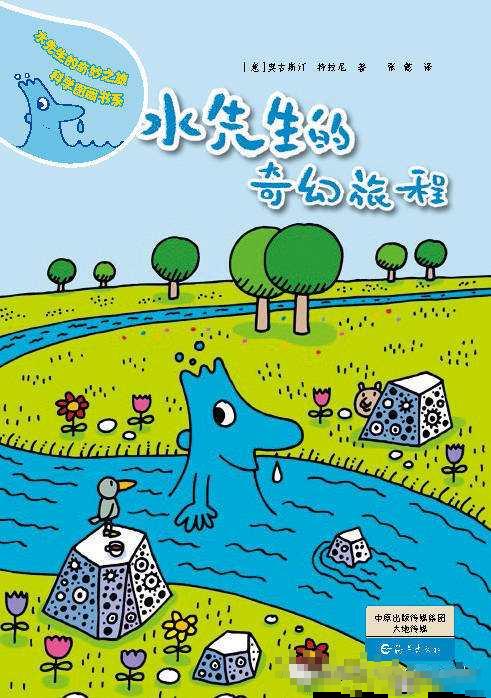
"Water" is such a magical substance, children should understand such a substance? "Water", "water", "H2O", the ocean is the earth's broadest body of water, accounting for 71.8% of the earth's area ...
"Mr. Water's Fantasy Journey" author Augustine M. Trani is a well-known Italian illustrator. In 2007, he was awarded the famous Italian prize "Fantasia-the city of Bari" (the 9th Bari City Fantasy Painting Award). The work has also been selected several times in the Bologna International Children's Book Fair.
Mr. Water's story begins with the sea.
The sea is a magical world, home to many wonderful creatures and Mr. Water. The author is a very playful person, he will tell you very directly, Mr. Water is who, where, without too much description, on the right side of the picture book page, above the whale, we saw the Italian with the characteristics of the big nose of Mr. Water, is walking in the microwave, Mr. Water's story starts from the sea.
“水”就是一个这么神奇物质,小朋友该如果理解这样一个物质呢?“水”、“water”、“H2O”,海洋是地球最广阔的水体,占地球面积71.8%……
《水先生的奇幻旅程》作者奥古斯汀· 特拉尼是意大利知名插画家。2007年曾获得意大利著名的the 9th prize drawing “Fantasia-the city of Bari”(第九届巴里市幻想绘画奖)。作品还曾多次入选博洛尼亚国际童书展。
水先生的故事先从大海说起
大海是一个神奇的世界,里面住着很多奇妙的生物,也是水先生的家。作者是一个很有玩心的人,他会非常直接地告诉你,水先生是谁,在哪,不用过多的形容描述,就在图画书页面的右边,鲸鱼的上方,我们看到了那个有着意大利人大鼻子特征的水先生,正在微波漫步,水先生的故事先从大海说起.....
(此绘本适合三岁以上的孩子)
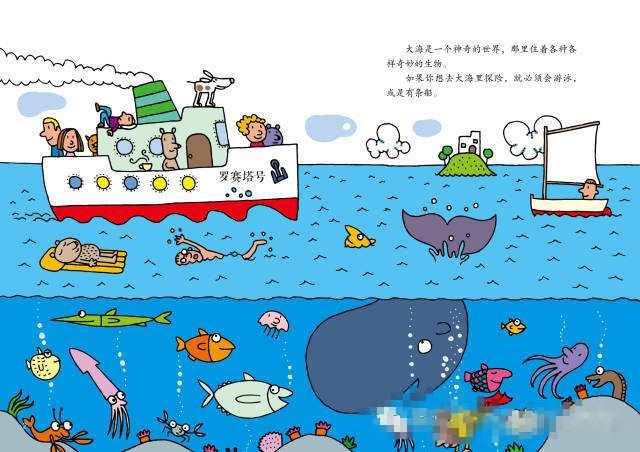
广阔的大海湛蓝无边,在这个神奇的世界里,住着各种各样奇妙的生物。人们在海里悠闲地游泳、潜水、沐浴阳光。
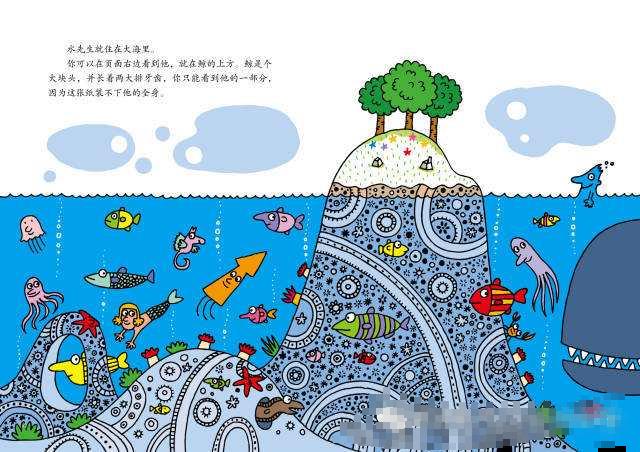
水先生就住在大海里。大家找到他了吗?海底真是一个奇妙的世界,好像宝石山一样。海底住着好多动物呀!(可以让小读者自己来探寻奇妙的海底世界,比如寻找海洋动物。)

水先生好调皮呀!瞧,他变成了大海浪,把长胡子爷爷的船翻了个脚朝天。海底的动物们也非常顽皮,长胡子爷爷的胡子都快被鱼儿们咬断了,好可怜哦!章鱼老师则是很认真的拿着警示牌警示着大家。
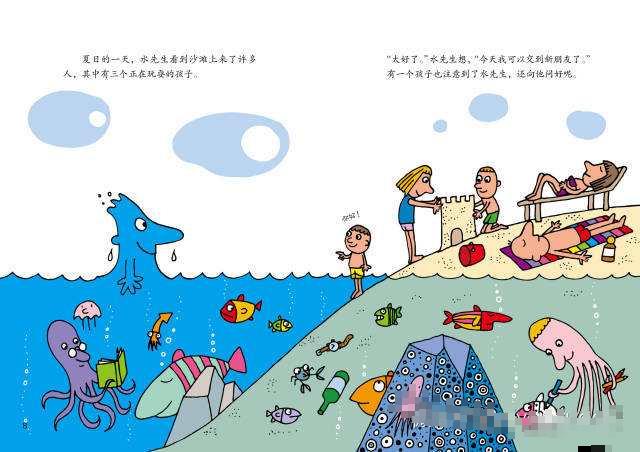
一天,水先生来到了海滩边。人们正在海边玩耍、晒太阳,他认识了三个小朋友。看,章鱼老师正在专心阅读,而章鱼甜甜正在绘画创作呢。
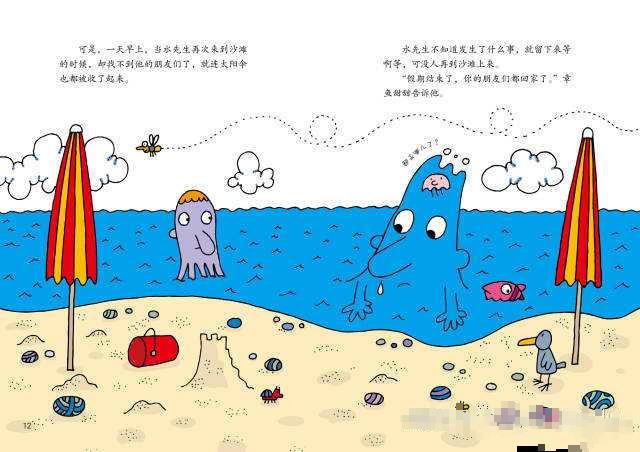
可是,快乐的时光总是那么短暂。“朋友们怎么都不见了”,水先生有些伤心。原来假期结束了,小朋友们都回家了。

水先生好想念朋友们,于是决定去寻找他们。在太阳公公的帮助下,水先生变成了一朵轻飘飘的云;空气太太也来助威,水先生飞快地飘过了田野和森林。(这些都是水先生的不种形态)
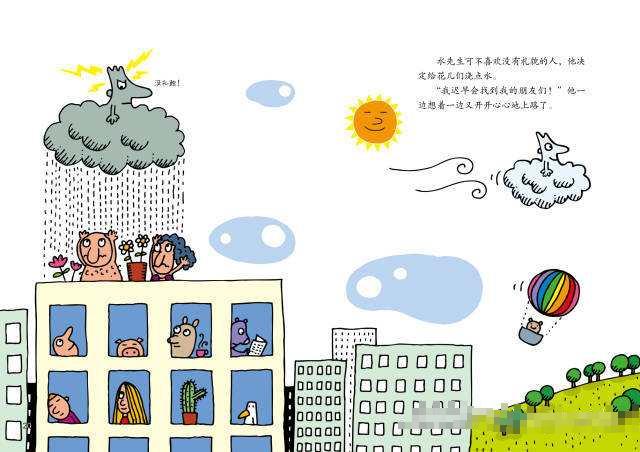
飘啊飘啊,水先生来到了一座城市。谁知道竟然遇到了两个没有礼貌的人,水先生生气极了,决定要教训他们一下。哇,水先生还能降雨啊!
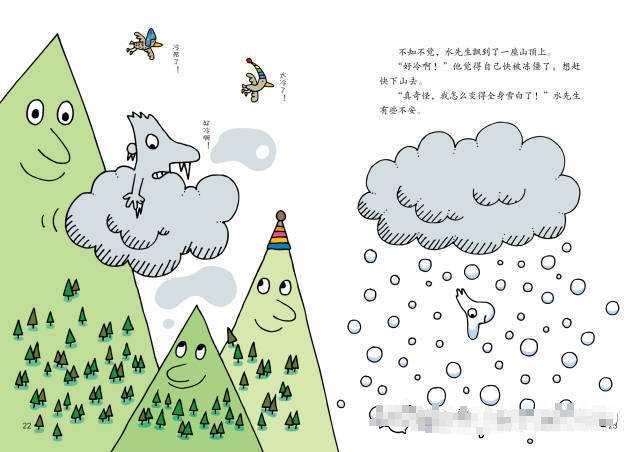
不知不觉中,水先生飘到了一座山顶。好冷啊,水先生怎么变成了雪白色,他渐渐地落了下来,最后变成了雪。
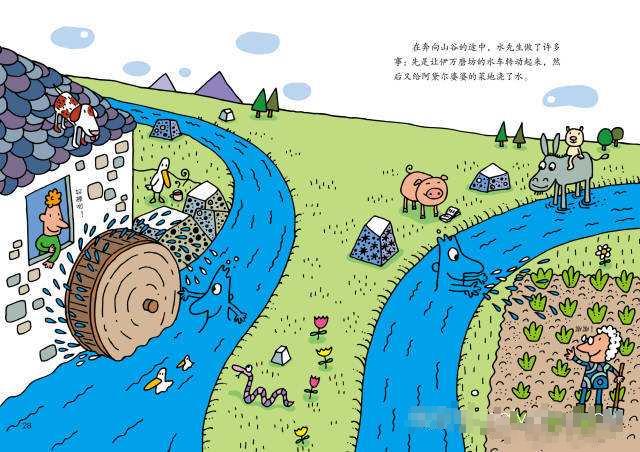
春天到了,花儿们绽放了,阳光把雪融化了,水先生又变成了水,继续上路去寻找他的朋友们。水先生好能干呀!看,他帮水车运转起来了,还帮花婆婆灌溉菜园。哇,小胖猪好爱读书哦,他正在草地上开心阅读呢。水先生流啊流,流啊流,来到了山脚下。
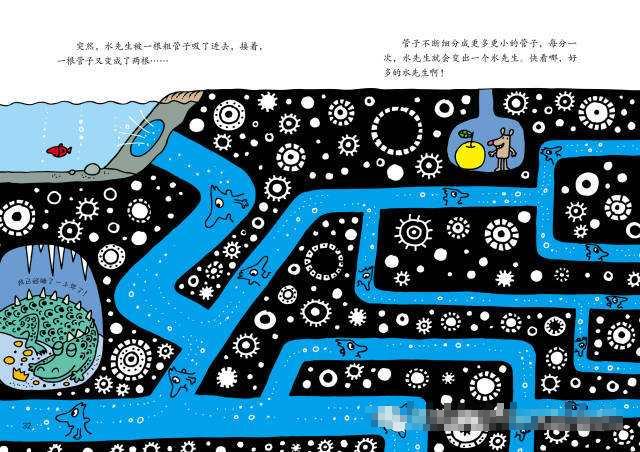
(这里色调突然变暗了)突然,出现了好多小管子,好多个水先生啊!这是要去哪里啊,水先生忐忑不安……

原来,水先生去了不同的地方,帮助了很多人,他好忙呀。
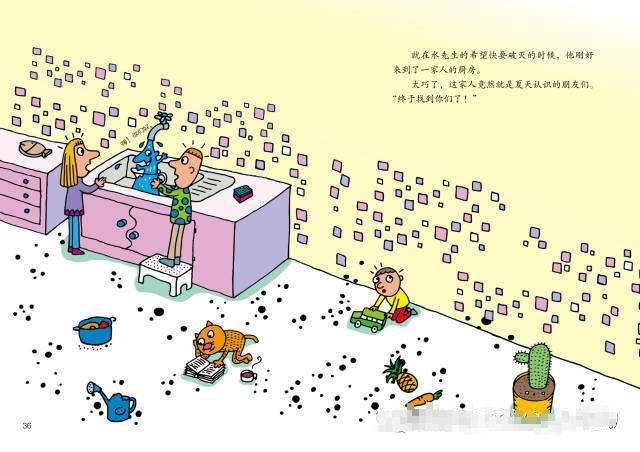
可找了这么久,水先生还是没有找到朋友们。别灰心,他来到了一家人的厨房。天哪,这家人不就是水先生要找的朋友们嘛。
关于水先生的小实验:
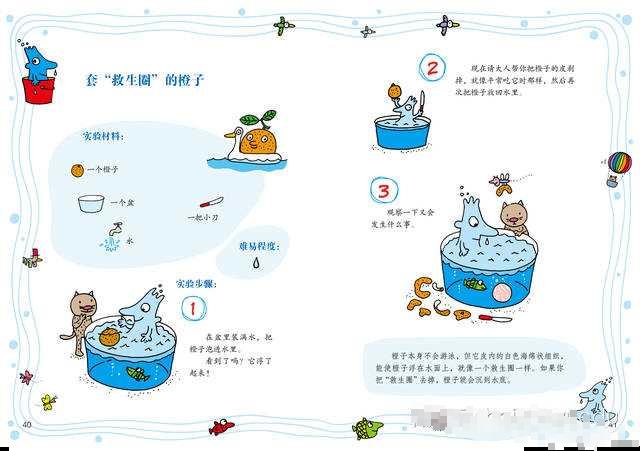
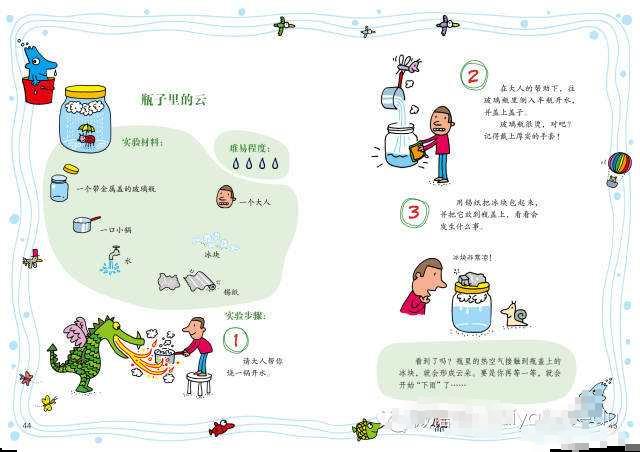

In nature, there are always a variety of wonders waiting for us to explore and discover. we hope you can learn more and gain more from the teachers' sharing. Let's look forward to the wonderful content next time.
大自然里,总是有着各种各样的神奇等着我们探索发现,希望大家在老师们的分享中可以认识更多收获更多,让我们期待下次的精彩内容。
以上是关于LUA分享——认识植物,培养孩子想象力与创造力的主要内容,如果未能解决你的问题,请参考以下文章